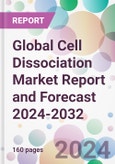Global Cell Dissociation Market Outlook
The global cell disassociation market size was valued at USD 456.1 million in 2023, driven by growing trend towards automation in cell dissociation across the world. The market size is anticipated to grow at a CAGR of 15 % during the forecast period of 2024-2032 to achieve a value of USD 1606.6 million by 2032.Cell Disassociation: Introduction
Cell dissociation is a laboratory process used to separate individual cells from tissues or cell clusters, transforming them into a single-cell suspension. This technique is essential for various biological and medical applications, including cell culture, cell counting, and various types of analyses like flow cytometry. Cell dissociation can be achieved through enzymatic or mechanical methods, depending on the cell type and the intended downstream application, ensuring the cells remain viable and intact for further study or use.Key Trends in the Global Cell Disassociation Market
Enzymatic dissociation methods continue to be preferred for their efficiency and the ability to maintain cell viability, especially in sensitive applications like stem cell research and regenerative medicine.Growing trend towards automation in cell dissociation to increase reproducibility, efficiency, and scalability of cell-based experiments and therapies.
Rising investments in cell therapy research, including stem cell and CAR-T cell therapies, are driving the demand for effective and gentle cell dissociation techniques that preserve cell integrity and functionality. Increased emphasis on gentle dissociation methods to maintain cell surface markers and improve the yield of viable cells for downstream applications.
Development of customized dissociation products tailored to specific cell types and applications, addressing the diverse needs of research and therapeutic fields. Stringent regulatory standards guiding the production and use of dissociation enzymes, ensuring product quality and safety, especially for clinical applications.
Global Cell Disassociation Market Segmentation
Market Breakup by Type
- Trypsin
- Papain
- DNase
- Hyaluronidase
- Instruments
Market Breakup by Tissue Type
- Connective Tissue
- Epithelial Tissue
Market Breakup by End User
- Pharma
- Biopharma
- Research Institutes
Market Breakup by Region
- North America
- Europe
- Asia Pacific
- Latin America
- Middle East and Africa
Global Cell Disassociation Market Overview
In North America, the cell dissociation market is characterized by strong research activities and advanced biotechnology sectors. There's a significant emphasis on automation and the development of non-enzymatic dissociation products to preserve cell viability and function, crucial for research and therapeutic applications. The region also shows a growing interest in personalized medicine and cell therapy, driving the demand for efficient and reliable cell dissociation techniques.Europe's cell dissociation market benefits from robust healthcare infrastructure and substantial investments in research and development. The region focuses on adopting gentle and efficient dissociation methods to maintain cell integrity, essential for clinical applications and regenerative medicine. There's also a strong emphasis on standardizing cell dissociation techniques to ensure reproducibility and reliability in research outcomes, aligning with the region's stringent regulatory standards.
The Asia Pacific region is experiencing rapid growth in the cell dissociation market, driven by expanding biotechnology sectors and increasing investments in life sciences research. Countries like China, Japan, and South Korea are at the forefront, emphasizing innovation in cell culture technologies and stem cell research. The region also shows a trend towards adopting advanced dissociation enzymes and equipment, catering to the growing needs of pharmaceutical and biotech industries.
Global Cell Disassociation Market: Competitor Landscape
The key features of the market report include patent analysis, grants analysis, clinical trials analysis, funding and investment analysis, partnerships, and collaborations analysis by the leading key players.- Merck KGaA
- Danaher Corporation
- Thermo Fisher Scientific, Inc
- Corning Incorporated
- Becton, Dickinson and Company
- STEMCELL Technologies
- Promo Cell GmbH
- Miltenyi Biotec
- ATCC
- HiMedia Laboratories
This product will be delivered within 5-7 business days.
Table of Contents
1 Preface
3 Global Cell Dissociation Market Overview
4 Global Cell Dissociation Market Landscape
5 Global Cell Dissociation Market Dynamics
6 Global Cell Dissociation Market Segmentation
7 North America Cell Dissociation Market
8 Europe Cell Dissociation Market
9 Asia Pacific Cell Dissociation Market
10 Latin America Cell Dissociation Market
11 Middle East and Africa Cell Dissociation Market
12 Regulatory Framework
13 Patent Analysis
14 Grants Analysis
15 Funding and Investment Analysis
16 Partnership and Collaborations Analysis
17 Supplier Landscape
19 Company Competitiveness Analysis (Additional Insight)
20 Payment Methods (Additional Insight)
Companies Mentioned
- Merck KGaA
- Danaher Corporation
- Thermo Fisher Scientific Inc
- Corning Incorporated
- Becton
- Dickinson and Company
- STEMCELL Technologies
- Promo Cell GmbH
- Miltenyi Biotec
- ATCC
- HiMedia Laboratories
Methodology

LOADING...
Table Information
| Report Attribute | Details |
|---|---|
| No. of Pages | 160 |
| Published | February 2024 |
| Forecast Period | 2024 - 2032 |
| Estimated Market Value ( USD | $ 0.53 Billion |
| Forecasted Market Value ( USD | $ 1.61 Billion |
| Compound Annual Growth Rate | 15.0% |
| Regions Covered | Global |
| No. of Companies Mentioned | 11 |








